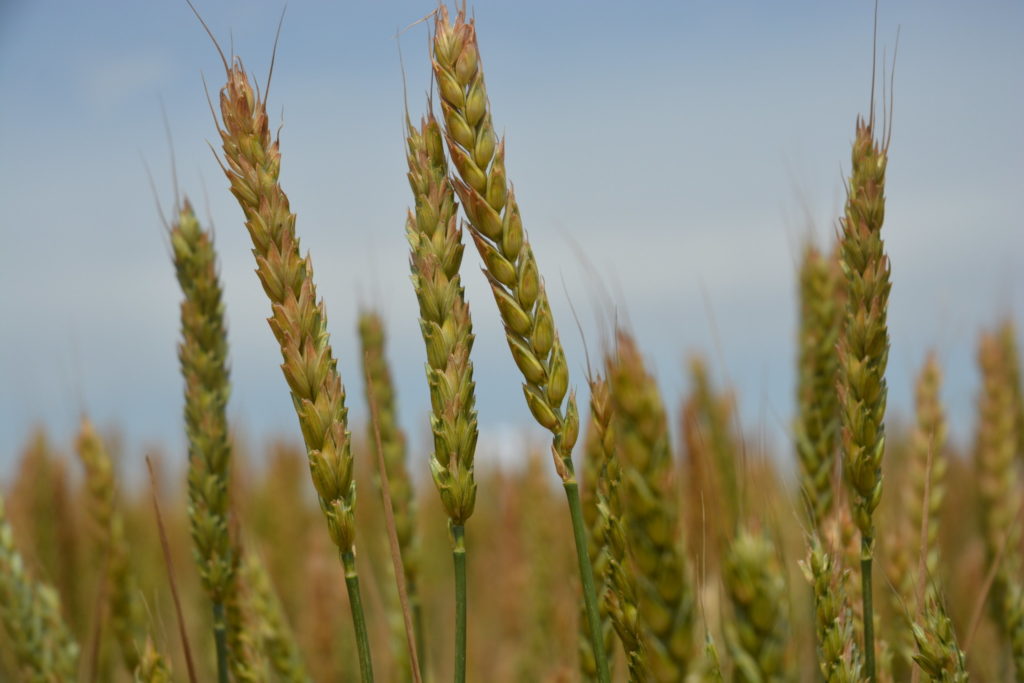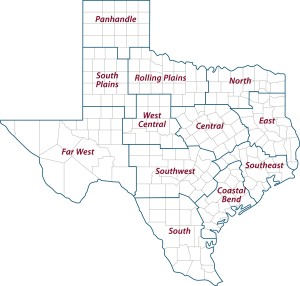Texas Crop and Weather Report
Texas wheat producers could see an opportunity as food grains show steadiness amid calamity for other commodities, said a Texas A&M AgriLife Extension Service economist.
Mark Welch, Ph.D, AgriLife Extension economist, College Station, said food grains have avoided much of the “complete wreck” market disruptions have made of commodities like corn, cotton, beef and crude oil. As dairy operators dump milk and oil markets report negative-sum prices, prices for wheat and rice remain relatively steady and have experienced brief gains during the COVID-19 crisis.

Cattle, corn and crude oil prices were all down at least 20% compared to wheat and rice, which were down around 3%-4%, Welch said.
“So many commodities are cloudy amid this crisis, but wheat and other food grains have held up,” he said. “I think it’s because COVID-19 has created underlying demand for these food grains as countries around the globe take an extended view of their food supplies.”
Welch said nations like Russia and Ukraine have already announced the possibility of limiting exports to make sure their people are fed. The pandemic timeline and overall growing conditions in those countries and other major wheat-growing nations going forward will weigh heavily on those decisions.
Weather in the U.S. this spring could also affect domestic decisions, Welch said. Freezes in Texas and Oklahoma damaged wheat destined for grain production, but it remains unclear if it will hurt overall yields.
AgriLife Extension agronomists estimated Texas grain-wheat acres could see up to a 10% yield loss based on reports in the state’s wheat growing regions. It’s also unclear how many Texas wheat acres were going to grain.
Wheat grazing or grain?
Many beef cattle producers graze winter wheat to pack pounds on winter calves. Most pull their herds off the wheat by mid-March to produce grain in mid-summer, however in recent years, cattle prices were steady enough amid poor grain prices to entice many producers to graze out rather than go to grain.
But this year, Welch said, falling cattle prices and steady prices for food grains might mean a higher number of producers could go to grain.
The decision window has been tricky this year because of COVID-19. The timing of falling cattle prices and wheat’s steadiness occurred around the extreme cutoff date for producers to pull cattle to produce grain, typically March 15, Welch said.
On March 16, wheat grain prices were $4.31 per bushel compared to $5.01 on Jan. 2, Welch said. But by March 25, grain prices gained 70 cents to end at $5.04 per bushel.
“It’ll be interesting to see what decision producers made based on the timing,” he said. “It looks like there might be some opportunity for Texas producers who made the decision to go to grain.”
Welch said there were other “pockets of concern,” such as drying conditions in parts of Kansas and the availability of workers at harvest. Grain harvests are highly mechanized, but they still require additional workers.
There is no shortage of wheat domestically or globally, but the pandemic has wheat-producing nations weighing various options without an end to the crisis in view, Welch said.
“The future of the wheat crop is raising some concerns, but the U.S. has an abundant wheat supply,” he said. “We have a lot of carryover wheat, and despite wheat acres being down slightly this year, production on those acres is usually very good.”
Another factor that muddies price futures is concern about food grain exports going forward, especially to China. Uncertainty about whether the Chinese can or will follow through with Phase 1 of their trade agreement is one of several factors in flux.
Rice around the globe
Texas rice producers had a rough start to 2020 due to drought conditions along the coast. Acres were expected to hold or increase, but it’s too early to tell where yields will be at harvest.
But overall, Welch said seven of the eight top rice producing countries – mostly in Southeast Asia – look to rebound from a tough 2019.
If those countries limit exports of their rice, it could put pressure on the market and drive prices higher, he said. Southeast Asia is expecting La Niña weather patterns, which typically deliver drier conditions during the upcoming growing season. Drought there could put additional pressure on global rice supplies.
“It’s still early on everything,” he said. “So much of it depends on whether we’ve turned the corner from a health and economic standpoint, and that is the great unknown. We don’t know if the commodity markets have hit bottom yet, but it is interesting to see food grains outperforming everything else.”
AgriLife Extension district reporters compiled the following summaries:

CENTRAL
Eastern portions of the district received up to 2 inches of rain with some hail. Other areas received trace amounts to 0.5 of an inch of rainfall. Grazing was reduced as winter grass growth slowed and a lack of moisture stunted summer grasses. Cotton planting continued, and corn looked very good. Producers fertilized corn. Hay producers sprayed pastures, and some began cutting and baling. Some slight wind and hail damage to crops like corn, sorghum, wheat and oats was reported. Some wheat and oats were being grazed out. Nearly all counties reported adequate soil moisture. Overall crop conditions were fair to good, and nearly all counties reported good overall rangeland, pasture and livestock conditions.
ROLLING PLAINS
Weather conditions were dry and hot in most areas. Some producers noticed freeze damage to wheat fields. Wheat crops continued to mature, and some producers were baling wheat for hay. Ranchers continued moving cattle off wheat pastures. Producers continued preparing fields for planting spring crops.
COASTAL BEND
Some areas reported rain amounts ranging from 0.5-1.5 inches, with 4-5 inches reported in parts of Wharton County. Despite rains, conditions continued to dry in most of the reporting area due to wind. All cotton was planted and had emerged. Corn and grain sorghum were in good condition, but fields were moisture-stressed in many areas. Herbicide and insecticide applications were made. About 40% of rice was at flood stage. Organic rice was yet to be planted. Producers were harvesting wheat and oats. Pasture conditions were fair but needed rain for spring green-up. Cattle were in good condition. First-generation pecan nut casebearer spraying continued.
EAST
Rainfall continued to be a factor for producers with some counties getting as much as 3 inches. Producers cut and baled hay in drier areas, like Anderson and Cherokee counties, with good yields reported. Pasture and rangeland conditions were good. Subsoil and topsoil conditions were adequate. Vegetable producers were planting and harvesting. Wheat fields looked good. Cattle markets had many producers concerned about unstable and/or low prices. Livestock were in fair to good condition. Horn flies and black flies continued to be a problem in Houston County. Feral hog damage remained a significant issue in most counties.
SOUTH PLAINS
No rain was reported. Temperature lows were in the 40s-50s with highs between the upper 60s to mid-90s. Wheat silage was being cut, and many growers were running planters to get corn and sorghum in the ground. A few producers started planting cotton. Cattle looked good, but pastures and rangelands could use some moisture.
PANHANDLE
Northern parts of the Panhandle reported adequate topsoil and subsoil moisture while southern areas reported very short topsoil and subsoil moisture levels. Central parts reported adequate topsoil and subsoil moisture. Pasture and rangeland conditions were poor to fair. Winter wheat conditions were fair to good. Above-normal temperatures and below-normal moisture was stressing dryland wheat in some areas. Irrigated wheat fields survived recent freezing temperatures and was heading out. About 50% of corn acreage was planted.
NORTH
Topsoil moisture levels were mostly adequate with some areas reporting short moisture levels. Rainfall ranged from none to 2 inches. Strong winds and daytime temperatures in the 80s and 90s dried soils. Wheat was in good condition, and corn conditions were poor to fair. Flies were stressing livestock. Feral hogs were active.
FAR WEST
Temperatures reached highs just above 100 degrees with lows in the low-50s. Less than 1 inch of rain was reported. High winds and arid conditions caused increased dust storms. Weather was beginning to concern producers. Fire dangers were also becoming a concern. Farmers continued to cut and bale wheat pastures for quality forage hay. They also began watering Coastal Bermuda grass patches. Wheat was maturing very quickly amid extreme temperatures. A few fields of cotton were planted. Those fields emerged and looked good as most producers were expected to begin planting soon. Watermelons took a beating from high winds but were finally starting to grow and extend their vines. Corn and sorghum were progressing despite early wind damage. Pecans looked poor following the late freeze last year. There were no reports of pecan nut casebearer, but producers were monitoring with traps and were ready to spray as a few pecan nut casebearer moths were reported. Alfalfa weevil finally disappeared due to higher temperatures. Cattle producers continued to sort and ship fall calves. Most were shipping small numbers in hopes of better prices to come. Producers continued to work sheep and goats and feed livestock and wildlife.
WEST CENTRAL
Conditions were warm, windy and dry. Topsoil moisture was drying out, and rainfall was needed to plant cotton in the coming month. Wheat was maturing and drying down. Sorghum and corn looked better with the warmer days, but rain will be needed soon. Pastures were full of cool-season grasses and forbs, but they were drying down quickly, and summer grasses were greening. Livestock were in good condition.
SOUTHEAST
Growing conditions were good. Some areas received up to 1.7 inches of rainfall. Jefferson County reported rice was progressing, but that cool fronts were confusing the crop and slowing growth. Rangeland and pasture ratings were excellent to poor with good reports being most common. Soil moisture levels ranged from adequate to surplus with adequate levels being most common.
SOUTHWEST
Moisture conditions continued to decline across most of the district, but most pastures and crops were in good shape. Hay harvest continued, and wheat harvest was starting. Pasture fertilization and weed spraying continued. The peach crop looked good, and corn was progressing well. Livestock conditions were good, though producers were still struggling with market volatility. Producers showed increased desire to feed out their livestock for a later sale. Lambs and kid goats were doing well.
SOUTH
Weather conditions were mild with very short to adequate soil moisture levels. Temperatures were rising. Most areas reported short to very short soil moisture. Fruit and vegetable growers were moving products. Wheat and oats continued to mature, and harvests should start soon. Red potato harvest continued, and chipper potato harvest should start soon. Pasture and range conditions were fair to good in wetter areas and very poor in dry areas. Supplemental feeding continued but was decreasing in areas where grazing improved. La Salle County and Starr County reported trace amounts of rain. Zavala County reported a good rain that should help forage and crop production. Mesquite trees were blooming and putting on their bean crop. Pear cactus bloomed and should start putting on tuna berries soon. Irrigated crops like Coastal Bermuda grass and other vegetables were in good condition. Corn, cotton and onions made good progress with onion harvest set to begin soon. Another wave of cabbage harvesting was expected to begin soon. Irrigated wheat showed good grain head development. Dryland wheat and oats remained in fair to poor condition. Dryland row crops were showing increased signs of moisture stress, and some were expected to fail with no rain in forecasts. Some ranchers were providing water for cattle and wildlife.
Source: Texas AgriLife Extension
